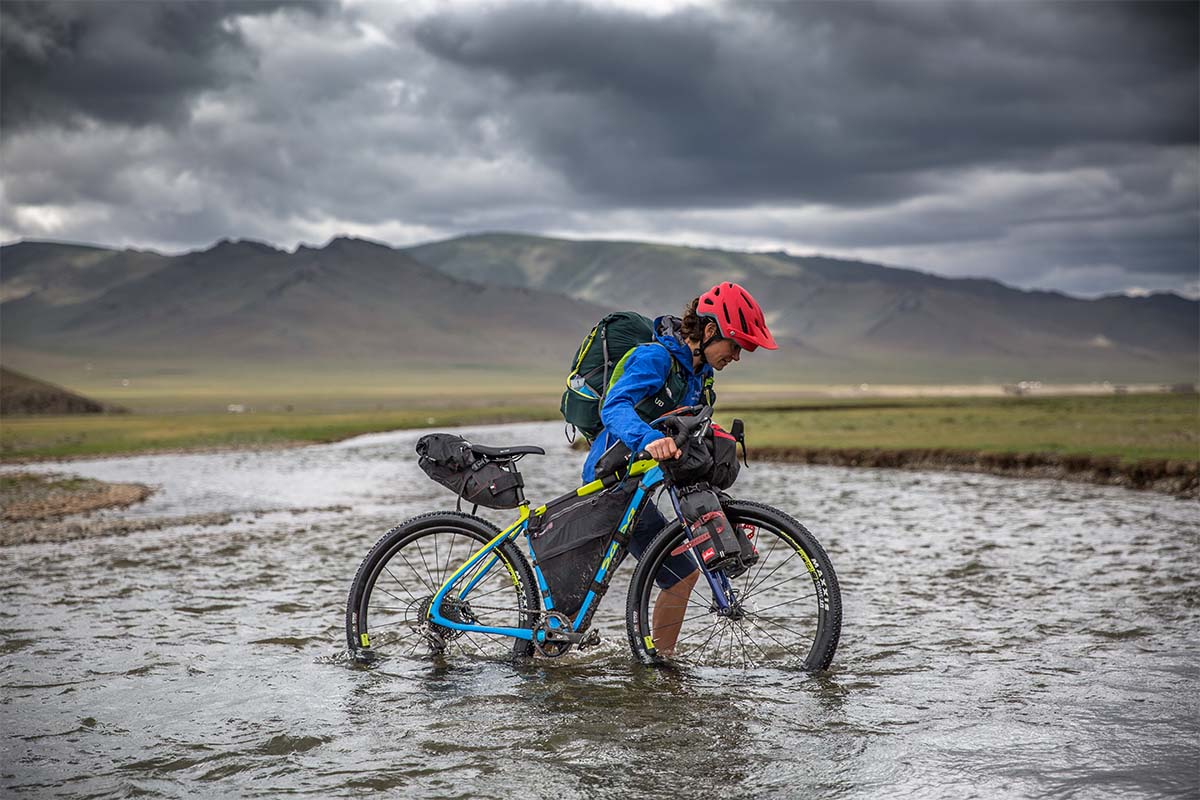
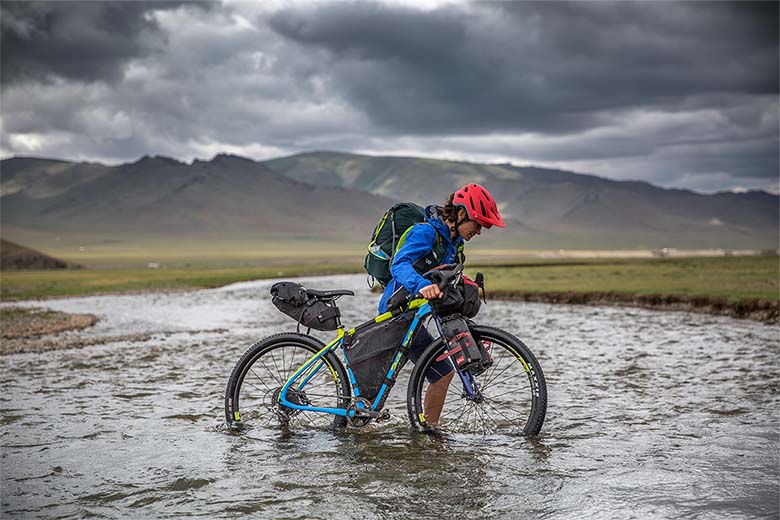
“Do you think that rain is coming our way?”
We pedal under the bright sun, constantly glancing nervously over our shoulders as if being chased by a predator. Behind us, dark gray streaks stretch vertically from ground to sky. Ahead, a rainbow frames our view. It’s a breathtaking scene of chaotic clouds and streaks of sunlight over the verdant steppes of central Mongolia.
“I think we have five more minutes,” I shout to Brian, who is clearly unconvinced by my optimism. Within 60 seconds, the storm sets in. .jpg)
We’d had the intriguing and mysterious land of Genghis Khan on our minds for quite some time. Mongolia isn’t a popular tourist destination—it's not often on the radar of even the most experienced travelers. Those who do visit typically head to the Gobi Desert or to the annual Naadam Festival—a long weekend of wrestling, horse racing, and archery held every summer. But we’d been shown enticing pictures from the Mongolia Bike Challenge—an intense six-stage mountain bike race—and fell in love with the wide-open skies, endless rolling hills, and bright green valleys. While Mongolia is far from the least-populated country on Earth (it's home to around three million people), the allure of such remoteness in a land of great beauty, few fences, and infinite campsites was hard to ignore. .jpg)
As forest fires inched closer and threatened our local plans back home in British Columbia, Mongolia—and the lush Khangai mountain range in particular—seemed like the perfect escape. We loaded up our new bikes and set off for an adventure that would end up exceeding our expectations, challenge us immensely, and deliver in ways we hadn’t expected. We’ve had some pretty epic trips, but we both agree this one is at the very top of our list.
Exhausted and jet-lagged from our flight to Ulaanbaatar (Mongolia’s capital), an eight-hour drive to Tsetserleg (which included a road-side tire rotation and lunch stop), bike building, gear and food packing, and a fitful sleep, we begin our journey. Under blue skies, we hopped on our bikes and hit the rough pavement, armed with enthusiasm and a .gpx track but little idea of the adventure ahead. Soon, we find ourselves on jeep tracks that stretch into the distance in every which way like spider webs. The steppes slowly come into focus—layers upon layers of rolling hills. Though not jagged or dramatic, their sheer vastness is breathtaking in a way that we Pacific Northwesterners only experience in the rocky, desolate alpine..jpg)
Our first couple of days are hot and exposed, and Brian suffers with the lack of shade. Each afternoon, we stop riding as the sun reaches its peak, setting up our tent to escape the intense rays. During this short time, we also quickly realize that designated roads are essentially non-existent—tracks spread out in all directions over open land with no barriers. Routes that appear parallel on maps most often are not, and we begin to rely upon GPS to navigate. .jpg)
We pass gers (rounded tent dwellings, similar to yurts) and their excited inhabitants wave us to join them. We turn down offers to ride horses, learn that aggressive dogs don’t want to pursue us if we stop and dismount, spot sacred mountaintop ovoos (stone and wood altars or shrines, similar to cairns) and spend countless hours marveling at the expansive, never-ending views. Yaks grunt and groan, herds of horses thunder by, and golden eagles glare as we pedal past. At night, the stars are brighter and more brilliant than either of us have ever experienced before. There are no cities nearby, and the few nomads living in the countryside have no electricity, meaning there’s no light pollution to spoil the view. The Milky Way seems almost close enough to touch. 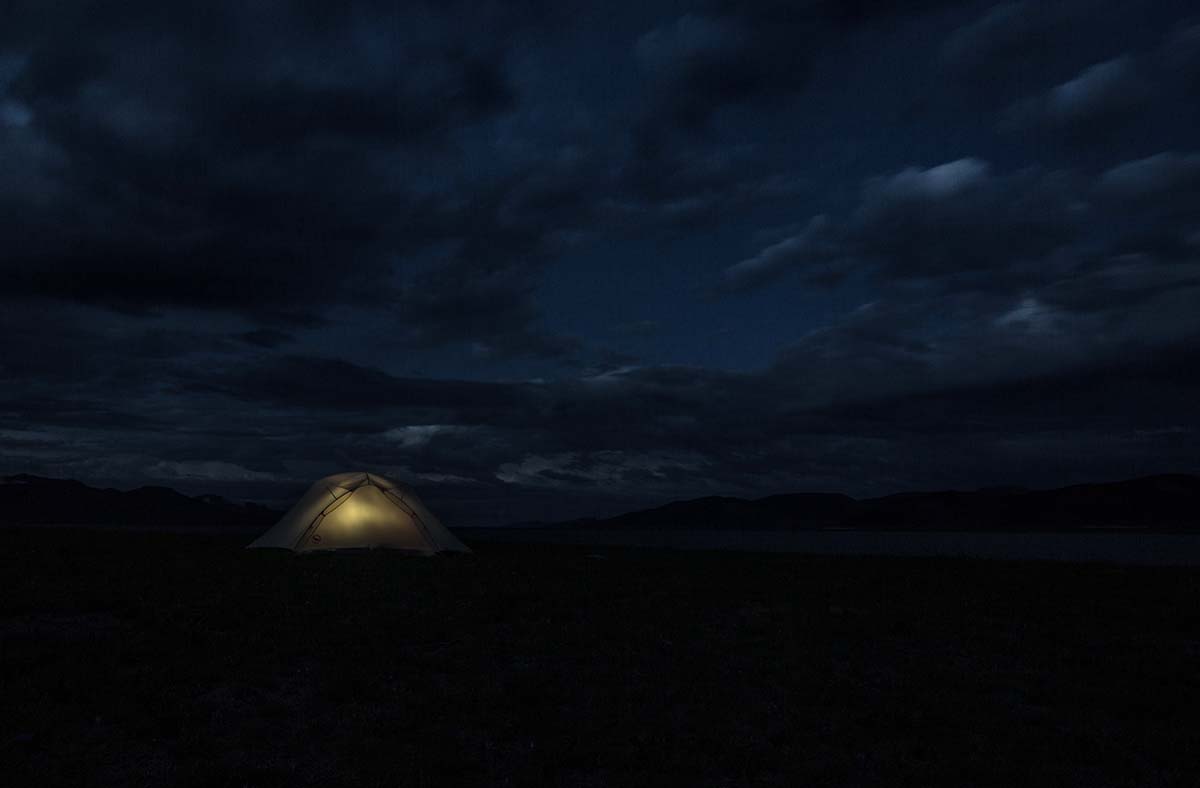
Aside from our need to escape the sun each afternoon, there are other challenges during the first couple of days. Our bikes and backpacks are heavy with camping gear, nine days’ worth of food, and 20 pounds of camera equipment. The gradual hills feel long and steep, the flies are incessant, and, on our first night, we’re approached by a drunk local looking for vodka. When he accepts that we have none, he instead insists we give him money. Thankfully, his friend pulls him away and we aren’t bothered again, but it’s an uncomfortable experience that casts an uneasy mood on our evening.
Progressively, though, things get better as we ease into the trip. On our second night, we’re rewarded with a stunning riverside campsite that we share with a herd of yaks. We watch them frolic (a word we’ve never before used when describing livestock) as the clouds converge, rainbows materialize, and raindrops begin to fall.
On our third day, the valley along the Chuluut River grows lusher, wildflowers are more abundant, and the hills are greener. As the scenery shifts, our track becomes more and more remote. A cold headwind signals the end of sunny days, and clear skies give way to dark storm clouds. The strong wind sucks the air from my lungs, forcing us to slow to what feels like a snail’s pace as we carry on along the valley floor. I try to dismiss concerns that we are low on water (and berate myself for not filling up earlier), convincing myself this is “type 2 fun” and forcing my legs to turn the pedals. .jpg)
An ovoo marks both the summit of our first major pass and the 100-mile mark of our ride, which brings us out of the Arkhangai Province into the Bayankhongor Province. After wasting time looking for ancient carved deer stones (whose location are mislabeled on our GPS) and filtering some questionable brown water, we attempt to outride an impending storm. Minutes later, when that plan doesn’t pan out, we pull over frantically to set up our tent, cook dinner, filter slightly cleaner water, and hunker down for what we hope is a passing storm. Wrong again. We remain trapped in our tent for 18 hours. Having only covered 25 miles over the course of the day, we start to question whether we’ll be able to complete our trip as intended..jpg)
When we wake the next morning, dark clouds remain, but it’s only sprinkling so we push on. As we descend into the vibrantly green valley, I recall that “khangai” is derived from a verb meaning “to provide; to supply with necessities.” Looking around, it’s easy to understand why the area has been inhabited for thousands of years and is considered a hub of nomadic civilization. Soon after that thought pops into my mind, we stumble upon our missing deer stones standing alone in the middle of nowhere. The flying deer that give the stones their name are thought to have been carved into these impressive rocks during the Bronze Age—around 3,000 years ago. How are there no signs, no fences, no tourists?.jpg)
The fourth day marks our five-year wedding anniversary, so we start the morning by celebrating appropriately with our one bag of “fancy” oatmeal (it’s heavy, so I’m happy to see it go). But the camping gods don’t seem to be on the same page. If there’s one true test of a relationship, it’s a day in the middle of Mongolia with four storms, multiple river crossings, strong headwinds, and washboarded roads. But with each storm, our tent set-up becomes more efficient and well-orchestrated. We marvel at the cloud formations and indulge in chocolate. We stop in the only two settlements on the journey, Jargalant and Zag, drink sweet juice and Coke, and stock up on Snickers bars. For dinner, we feast on our favorite dehydrated meal, Pho, and toast our anniversary while hiding from a sandstorm that preceded powerful thunder and lightning. Only four days into the trip, we dub our tent “Knox” (after the fort, of course), as we try to recall how well aluminum conducts electricity..jpg)
We start the day with a long ride through the high desert—no water or trees to be seen, and no signs of life other than chirping from what we think are baby birds hiding in the dust. The bumpy road ascends gradually as we weave between tracks in search of smoother lines. We grit our teeth and carry on until we reach another ovoo, which marks the start of a lengthy and blissful descent before crossing a creek and filling up on much-needed water. Dramatic clouds and ominous dark streaks continue to loom all around, encircling us, but we pedal in bright sun over easier terrain. .jpg)
Soon, it’s again time to hurriedly pitch Knox, which ends up being right next to a lovely river and closer to a ger than we had ever been. As night falls, a single motorcycle carrying what we learn to be four brothers sputters by and promptly breaks down right by our tent. They graciously accept Brian’s assistance getting them back up and running, and soon return on a horse. We enter enthusiastically pantomimed “conversations” about the weather, horses, our camping gear, and their ger. They demonstrate Mongolian wrestling and invite us back to their abode to play games (or at least, we think they do). We roughly sign our need for sleep, which they accept, and they retreat. As we settle in for the night, we watch the men through the fabric of the tent wrestle each other late into the evening. .jpg)
We cross our highest pass on day six, signaling our re-entry into the Arkhangai Province and the 200-mile mark of our ride. We cross more rivers, including two that go above Brian’s waist. I wade through what I can, but Brian carries me like a princess (or sack of potatoes, take your pick) over those I can’t. In the evening, we face our worst storm yet. Thunder shakes the ground around our tent and lightning flashes nearby. We fear that the pelting hail and winds will shatter Knox, leaving us exposed in treeless and shelter-less terrain. But after an hour of holding our breath, it finally subsides and we’re able to breathe a sigh of relief and remove our Gore-Tex outer layers that we’d donned just in case. Several more storms follow, but we have confidence in our indestructible fortress and are able to relax a bit..jpg)
Finally, the ride starts to feel easy—something we haven’t experienced yet. We’re nearing the end of our journey, so we spend extra time simply enjoying the steppes that have been our home for the past week. We pedal along Terkhiin Tsagaan Lake (“White Lake,” though it isn’t white) and spend our last evening camping along its shores. We save 19 miles for our last day solely because we’re not yet ready for this adventure to come to a close. The green peninsulas jutting into the water, sandy spits, and rocky hills are a stark contrast to the rolling steppes that dominated our first six days. Muscles sore, calves and forearms tanned, lips chapped, and hair matted, we are blissfully content..jpg)
Our last day leads us along the north shore of the lake and slowly back into civilization. Tourist ger camps pop up and buses full of out-of-towners eye us with curiosity. When we cross a bridge into the village of Tariat, we are exhausted and elated. It’s been an amazing adventure..jpg)
Mongolia is like nowhere else we’ve ever been, and we felt as though we were transported back in time. Not surprisingly, we went days seeing only a small handful of nomads and no tourists other than a single couple from India who were completing a similar route on motorbikes. Herdsmen and their families do have vehicles but are far more dependent on their horses. The day we completed our bikepack, the country experienced a two-day power outage. Inconveniently, it happened during our first shower in nine days—that spanned eight aimags (provinces), yet only those in small towns seemed affected (those in the countryside are used to much simpler living). There is purity and beauty to the landscape that’s echoed in the people and their lifestyle—or maybe the other way around—that’s unlike anything we’ve ever encountered..jpg)
International flights land in Ulaanbaatar, the nation’s capital. We booked accommodations in the city the first night, and they were able to arrange a shuttle from the airport for us for $12—the driver impressively fit all our gear and bikes into a Prius without issue. From Ulaanbaatar, you can bus to Tsetserleg for around $15 one-way (the ride is about 7-8 hours and departs from the Dragon bus station at 8am daily). Because we arrived during Naadam, there was uncertainty as to whether or not the bus could accommodate our bikes, so to save ourselves the added stress, we opted for a private taxi instead (around $185). We then arranged a ride back to Tsetserleg from Tariat on our last day ($120). The 112-mile road between the two towns is mostly paved and notably beautiful, but also fairly busy and would not have been an exciting bike ride, in our opinion. .jpg)
Upon arrival in Ulaanbaatar, we stayed in the Zaya Guest House. We paid $32 for the night, which was well worth it. It was clean, the showers were nice, and the staff allowed us to store our bikes and extra luggage when we headed west to trek in the Tavan Bogd after our bikepacking trip. In Tsetserleg, we stayed at the Fairfield Guest House Café and Bakery, and cannot sing its praises enough. The two Australian owners, Murray and Elizabeth, were extremely helpful. Once on our bikes, camping was plentiful and abundant—you can pretty much pitch a tent wherever you want. We chose spots near water whenever possible, though that only ended up being five of our seven campsites..jpg)
The first few days are the most difficult, by far. The climbs are steeper and the roads more technical than the rest of the journey. It was much easier to cover significant mileage during the second half of the ride, which is worth keeping in mind when planning your journey. If the weather cooperates, the 300 miles can be covered in six days if you aim for 45-mile days for the first three days and 55 for the remaining three. That said, conditions are notoriously unpredictable in the Khangai steppes, so expect wind and rain at least some of the time. With that in mind, we recommend planning for seven to eight days and taking your time near the end like we did. 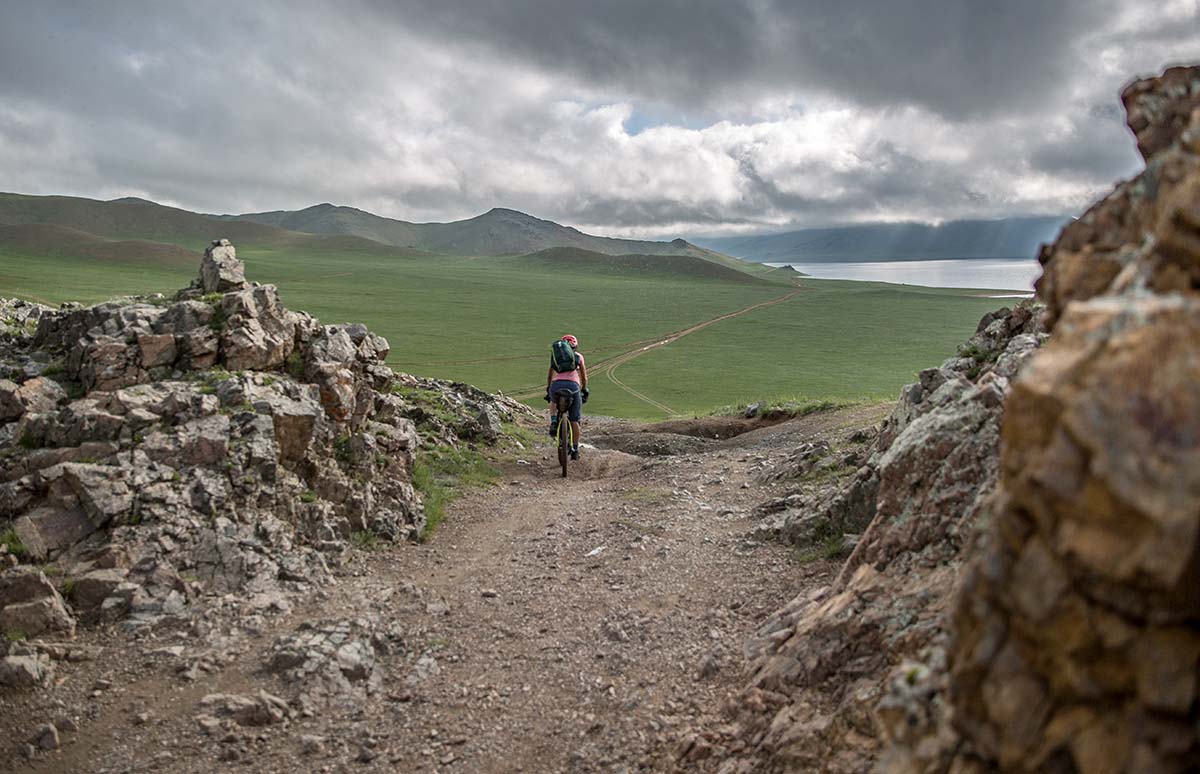
Biking in the Khangai steppes is demanding and unpredictable, so it’s important to bring along the appropriate gear. Our Curve GMX and Salsa Cutthroat adventure bikes performed flawlessly—they’re both drop-bar twenty-niners with mountain bike gearing and tire clearance. In terms of priorities, we wouldn’t suggest going any smaller than 2.25 mountain bike tires and at least a 11-42 cassette. We had no mechanical issues, but it is important to bring all the bits and pieces to fix a bike at roadside since you won’t come across a single shop capable of replacing broken parts while on this ride. For storage, we used frame, saddle, and handlebar bags from Revelate Designs, mounted Salsa Anything cages on the forks, and carried 25-liter daypacks (the Ultimate Direction Fastpack 25) for lightweight items..jpg)
In terms of a tent, we brought the Big Agnes Copper Spur 3 Platinum and appreciated the added space of the three-person version (see our in-depth review here). We faced heavy rain, strong winds, and daily storms, and this 3-season tent performed admirably. In addition, we each had a Western Mountaineering Summerlite sleeping bag and an Exped Synmat HL Duo sleeping pad, which similarly kept us cozy. For cooking, we used a Primus OmniLite Ti and two one-liter bottles of (bad) Mongolian petrol. To purify water, our MSR Guardian was also incredibly key as water sources are spread out and not exactly crystal-clear. We highly recommend a similar system unless you plan to boil all of your water—don’t count on being able to buy tablets in Ulaanbaatar. Finally, for safety, we used a Garmin inReach Explorer+, as well as Goal Zero Nomad solar panels and batteries. 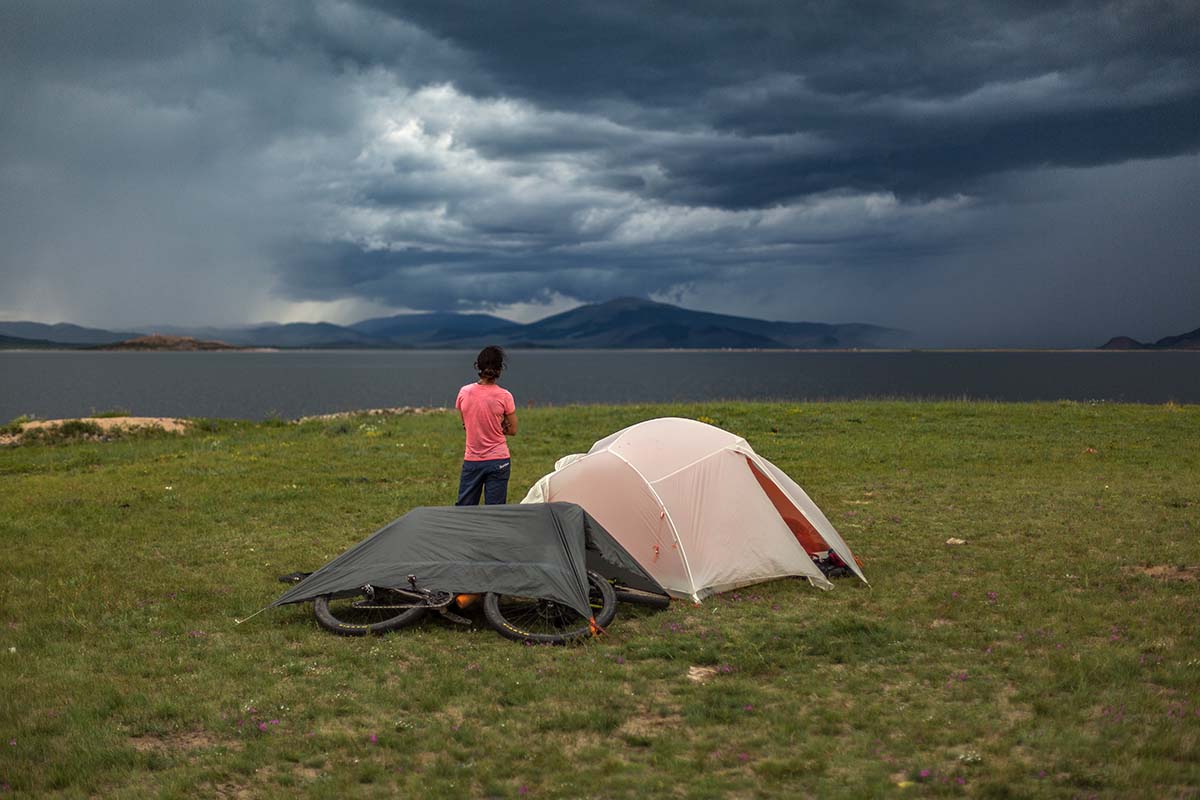
Weather was extremely variable—from bright and sunny to downpour in a matter of minutes—meaning you should plan appropriately when laying out your clothing. We made it a point to travel in July when temperatures were pleasant, and days typically hovered around 80 degrees Fahrenheit, while nights dipped to the low 40s.
.jpg)
.jpg)
.jpg)